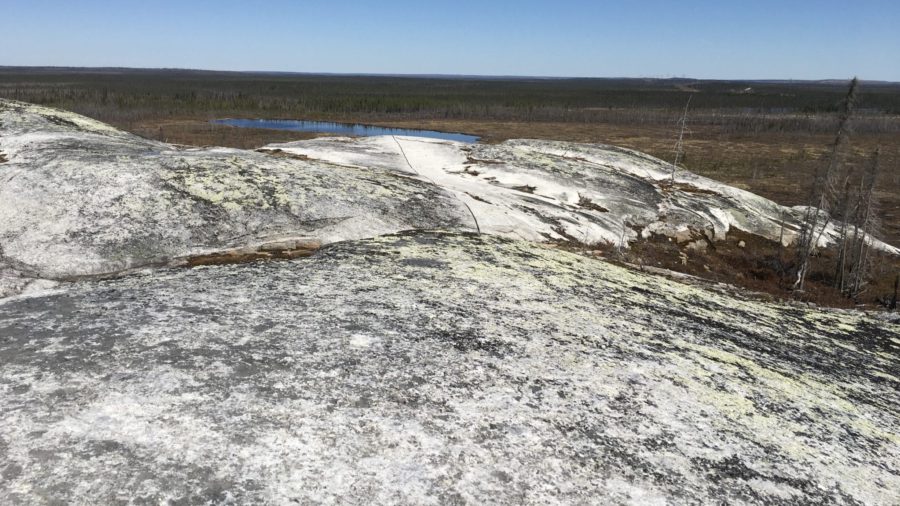Glencore digs deep in Sudbury

Glencore’s Onaping Depth project lies deep underneath its Craig mine, near Sudbury. CREDIT: GLENCORE
As a long-lived mining jurisdiction, the mines in Sudbury, Ont., are only getting deeper and more expensive to develop. And at less than US$6 per lb. at press time, the price of nickel isn’t exactly soaring.

Peter Xavier
But Peter Xavier, vice-president of Glencore’s Sudbury Integrated Nickel Operations (INO), hasn’t been more confident in the future of the operations in years.
Glencore’s US$700-million Onaping Depth project is under construction, the company is evaluating a deep project at its Nickel Rim mine, and it’s turning up promising results at its Norman West project near Capreol.
“We have a strong set of operations now, we have one project being built, one on the cusp of moving forward and then from an exploration perspective, we see further potential even beyond that,” he said in an interview in Glencore’s Sudbury offices in November. “For us in Sudbury it’s been decades since we’ve had that type of vision on our longevity. We were always facing depleting reserves, we didn’t always have an option for what was next.”
Xavier joined Falconbridge in 2001, before the company was taken over by Xstrata in 2006 and then Glencore in 2013.
In 2015, he was promoted to his current role, overseeing the Sudbury operations, which include the Nickel Rim South and Fraser mines, Strathcona mill and Sudbury smelter.
The company’s newest project, Onaping Depth, was approved in early 2018 and will see first ore by 2023.
Onaping Depth, located just northwest of Sudbury, was first discovered in 1994 below the Craig mine, but despite its high grades, at 2.5 km depth, it hasn’t been feasible until recently.
“When Onaping was first discovered back in the ‘90s, it was quite deep for Sudbury and there were a lot of unknowns around mining at that depth,” Xavier explains. “What’s since happened is up in Timmins our sister operation in the zinc group, the Kidd mine, has developed down to those levels; Vale’s Creighton as well; and Agnico’s LaRonde in Quebec – so there’s been a lot of learning, understanding from the geotechnical context.”
Deep mining
The challenges of deep mining are both economic and technical.
“Naturally, these deposits are more expensive. They’re more capital intensive to develop and the time before you get first ore or first revenue is much longer. So your traditional net present value and internal rate of return calculations are going in the wrong direction,” Xavier says.
And given their depth, the deposits harder to find, explore and define.
From a technical perspective, there are also geotechnical, heat and logistical challenges.
“At Onaping Depth, we have ambient rock temperatures of 40-50°Celsius, so we have to think of things we never had to think of before, like cooling,” Xavier adds.
“And then obviously logistics – deeper means people, materials, all your services – they just have that much farther to go, and all your material you’re bringing out, the ore, is having to go that much farther to come out against gravity. So all else being equal, everything is going to a higher degree of difficulty and complexity.”
It’s in that context that the INO division got the project approved after many years of work. Onaping Depth contains mineable indicated resources of 13.8 million tonnes grading 2.25% nickel and 1.02% copper.
The US$700-million project was approved in late 2017, with initial development beginning on the two primary headings required to develop the internal shaft earlier that year.
Learnings from other recently developed deep mines have helped inform the mine design to make Onaping Depth viable. But the real game changer has been battery electric technology. In late 2016, the company completed a feasibility study on Onaping Depth and made the decision to go battery electric, which made a big difference in the overall economics.
“On the ventilation side, going battery-electric means that machine requires a lot less air, even from a regulatory perspective because we have no contaminants to clear,” says Xavier, a mine engineer and graduate of Laurentian University. “You then can resize your heating, your cooling and your ventilation systems, which saves you a lot of capital and operating cost in the future. So when you put that all together, that’s what brought a tremendous benefit to the mine.”
Going electric means a 44% reduction in greenhouse gas emissions, a 40% reduction in ventilation requirements and a 41% reduction in overall power required. It also allows for a 23% reduction in shaft diameter.
From a production point of view, diesel-free equipment also makes sense because it adds operational flexibility – in traditional mines, air flow regulations limit the number of pieces of equipment you can run in any particular area because of emissions.
Glencore has been testing battery equipment from multiple OEMs, including MacLean Engineering (bolters and boom trucks), Papa Bravo and Sudbury-based Industrial Fabrication (mine carriers), Epiroc (jumbos), Caterpillar (LHDs), as well as diesel-converted equipment from MineCat and Marcotte Mining.
“Everything we buy today we look to see if there’s a battery- electric equivalent on the market. In some cases it’s not the right time to buy it and in other cases we do to gain exposure, gain confidence and start to learn it,” Xavier says.
“Ontario is where you see most of the BEV activity happening,” Xavier observes, adding that colleagues from other operations across Glencore have visited their operations to see the machines in action.
Mines in Ontario are among the first where there’s a solid economic case for battery electric without subsidies, he says.
“Maybe it’s because of the combination of our depth and the regulations around ventilation, as well as the heat at depth, the need to heat and cool our air,” he says.
In the meantime, development at Onaping Depth is well under way. Lateral development has been carried out by DMC Mining, a subsidiary of KGHM. Although the Craig mine ceased production in 2009, KGHM has been using the infrastructure to mine its Morrison deposit, which is located between the Craig and Levack shafts.
“The good thing for us is it kept the operation maintained and being used which was a very good thing and one of the enablers for Onaping Depth because you can imagine if this was sitting idle since 2009, they would need a lot more capital to get back up and running,” Xavier says.
Glencore and KGHM are currently sharing the Craig infrastructure, but KGHM will be moving to access its deposit through the Levack shaft.
The Craig shaft extends to about 1.5 km depth and is located about 1 km horizontally from where the new internal Onaping Depth shaft will be. The internal shaft, which will involve setting up an underground headframe, will start at the 1,200- metre level and extend to the 2,630-metre level, or 1,430 metres in length. The contract to develop the 7.2-metre-diameter production shaft has been awarded to Cementation, with work expected to begin towards the end of the year. Development also includes the construction of hoistrooms and a bulk air cooling plant.
Battery electric advances
Understanding that battery electric equipment would play a big part in the future of deep mining, Glencore has been actively involved in pushing OEMs to develop common standards through the Global Mining Standards and Guidelines Group.
Glencore Sudbury wanted to avoid an iPhone-type situation where different chargers are needed for different devices, Xavier says.
“You have to get consistency on those types of things, whether it’s battery swapping or charging, get those systems standardized.”
Even as development work continues at Onaping Depth, battery technology is rapidly improving. Quick-charging is getting better and faster (as little as 15-20 minutes for some machines) and even battery swapping is becoming less cumbersome. Whereas a crane might have been necessary to swap batteries in the past, there are now “cassette” options that make swapping faster and easier and don’t require specialized equipment.
Even so, Glencore has anticipated that there may still be limitations on battery power when the equipment is needed in mid-2022, particularly with the ability of large 40-50 tonne trucks to haul loads uphill.
To mitigate against that risk, the company has incorporated changes in its mine design, Xavier says, with the design allowing trucks to haul loads downhill to the final dump point, and boosting the battery as they go through regenerative braking technology.
Future of mining
The future of mining in Sudbury is deep mining, and it’s shaping new technology and innovation in mining.
“Going deeper in Sudbury is a natural consequence of mining here for a long time, thereby having exhausted the near-surface deposits presents a unique set of challenges. So I think the approach is now to match up the areas of innovation and technology to address those challenges and ensure a sustainable future,” Xavier says.
Glencore INO’s vision for those sustainable future operations is electric, digitally connected and involves minimizing waste.
The company is already making use of automation where it makes sense: its rockbreakers at Nickel Rim are remotely operated from surface, while its production scoops are partially automated. Operators drive them until they get to an open production stope, where they get off the machine and remotely drive the machine in and out.
“Right now, the algorithms are not quite efficient enough to ensure a full bucket each time, so basically the operator does that and from there he puts it on autonomous and it drives to the dump point by itself, it dumps, and it comes back by itself.”
While automation creates a lot of safety and productivity benefits, at the end of the day mining is still a batch process with discrete drill, blast and muck cycles that’s fragmented and less efficient than it could be, Xavier says.
“In order to go fully autonomous you have to figure out how to go to continuous first,” he says, adding that Glencore is participating in a Canadian Mining Innovation Council (CMIC) working group on continuous mining. “Once you’re continuous, now you’re getting into a much simpler process that then is more amenable to automate.”





Comments